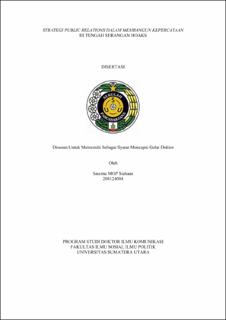| dc.contributor.advisor | Zulkarnain, Iskandar | |
| dc.contributor.advisor | Kurniawati, Dewi | |
| dc.contributor.advisor | Asmara, Sakhyan | |
| dc.contributor.author | Siahaan, Saurma Marodor Godang Parulian | |
| dc.date.accessioned | 2025-07-21T06:37:14Z | |
| dc.date.available | 2025-07-21T06:37:14Z | |
| dc.date.issued | 2025 | |
| dc.identifier.uri | https://repositori.usu.ac.id/handle/123456789/105989 | |
| dc.description.abstract | This study explores Public Relations Strategies in Building Trust Amidst Hoax Attacks, employing a qualitative methods through data collection via interviews and documentation. Interviews were conducted with four public relations practitioners from the Central Executive Board of the Indonesian Public Relations Association (BPP PERHUMAS) who have fulfilled the criteria of having decades of experience in communication and managing hoaxes. The researcher also conducted credibility testing through triangulation with the Director General of Public Information and Communication at the Ministry of Communication and Information Technology of the Republic of Indonesia, who also serves as an Advisor to PERHUMAS and the Chief of the Global Alliance Asia Pacific Regional, a regional-level public relations association. The objective of this study is to identify how public relations strategies are implemented in building trust amidst hoax attacks, to determine supporting factors, and to outline the strategic phases involved. The finding indicate that positive campaigns and measuring public trust are essential strategies for public relations in building trust during hoax crises. Various strategies can be utilized in this context, and as proposed by the researcher, public relations practitioners may combine strategies previously introduced by experts-namely, the crisis communication strategy derived from the Situational Crisis Communication Theory (SCCT) by Timothy W. Coombs (2007), the Image Repair Theory by Ronald D. Smith (2009)- while adjusting them to the spesific types of hoaxes encountered. The success of these strategies is greatly influenced by organizational support, including the establishment of hoax-related policies, the presence of standard operating procedures (SOPs), special task forces, and the competencies of public relations professionals. With a series of strategic steps supported by advancements in communication technology and a comprehensive approach, public relations is expected to effectively build public trust amidst hoax attacks. | en_US |
| dc.language.iso | id | en_US |
| dc.publisher | Universitas Sumatera Utara | en_US |
| dc.subject | Hoaxes | en_US |
| dc.subject | Public Relations Practitioners | en_US |
| dc.subject | Communication Crisis | en_US |
| dc.subject | Public Relations Strategy | en_US |
| dc.title | Strategi Public Relations Dalam Membangun Kepercayaan di Tengah Serangan Hoaks | en_US |
| dc.title.alternative | Public Relations Strategy a Building Trust Amidst Hoax Attacks | en_US |
| dc.type | Thesis | en_US |
| dc.identifier.nim | NIM208124004 | |
| dc.identifier.nidn | NIDN0003096603 | |
| dc.identifier.nidn | NIDN0024056502 | |
| dc.identifier.nidn | NIDN0017095605 | |
| dc.identifier.kodeprodi | KODEPRODI70001#IlmuKomunikasi | |
| dc.description.pages | 221 Pages | en_US |
| dc.description.type | Disertasi Doktor | en_US |
| dc.subject.sdgs | SDGs 4. Quality Education | en_US |


